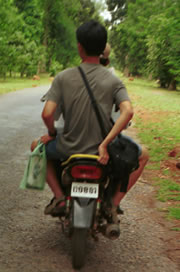
Fear and loathing in Cambodia (29.06.01 - 06.07.01)Part two: It's tiring to travel in CambodiaThird day at Siem Reap, I told Gunter (who was rooming with me)
that I was feeling tired. Physically, the sheer mass of the Angkor monument and the equatorial
climate (with the erratic torrential downpours) had taken the toll
on me. Blood in my bowels. You don't get much worse than that unless
you are foaming in your mouth. Gunter told me after talking to some other travelers living in
the same guesthouse that I had by far the most ambitious plan to
'conquer' the monuments, so as to utilize our three-day pass (which
cost us USD$40 each) to the maximum. Exercising common sense meant that we started the first day brightly.
Getting a car for USD$20 for the four of us the whole day was cheaper
than getting a motorcycle at USD$6 each. The first day was the overview,
we went on the Grand Circuit in the anti-clockwise direction, starting
at Prasat Kravan and ending the day at Angkor Wat. The overview
allowed us to know which sights to go back to for the next two days. However, I realized that the continuous exposures to these awesome
monuments soon reduce them into a blur. The next day, in order to appreciate the sights better, I chose
to concentrate on Banteay K'dei, Prah Khan and Angkor Thom. If you
think it doesn't sound much, I urge you to think again. These three sights were constructed during the reign of Jayavarman
VII (which lasted from 1181 to 1220), undisputedly the last of the
great god-kings from the Khmer civilization. There were intense
speculations that the Khmer civilization faltered at the end of
the 13th century because Jayavarman VII had wasted so much of his
empire's resources into building these monuments. Take Angkor Thom (literally meaning 'The Great City') for instance.
Being the last capital of the Khmer civilization, it encompasses
an area of 145.8 hectares, speculated to be grander than any city
in Europe at the time, supporting a million people within its compounds.
Within the laterite wall laid on a square grid which is about three
kilometers on each side, Angkor Thom includes the Bayon (easily
my favorite), the Terrace of the Elephants, Terrace of the Leper
King, the Prasat Suor Prat and earlier monuments such as the Baphuon
and Phimeanakas. By the third day, fatigue had completely overwhelmed me as I woke
up feverishly, and could only do the Roluos Group (which included
Preah Ko, Baking and Lolei) in the morning, while sleeping through
the afternoon. With the monuments attributed to Indravarman I (reigned
877--889) and Yasovarman I (reigned 889--910), the group showcased
early Khmer art and provided an excellent counterpoint to the main
sights on the Grand Circuit. And then more importantly, there was the mental fatigue related
to the poverty you would see on the streets. And the poverty was
not the overt kind that everyone seemed to be well prepared. We
knew we would find beggars coming at us or children sniffing glue
on the streets. But really, it's the covert desperation that kills. First day ay Siem Reap, we met a Chinese restaurant run by a Beijing
cook. I half-heartedly asked him while eating the dumplings he had
prepared for us, what was in store for us in Siem Reap. He replied
without hesitation: "One, the Angkor monuments. Secondly, the
woman. Just USD$5. Very cheap." Every moto driver would 'volunteer' to take you to such clubs. Gunter met with a French missionary who was a volunteer up north
with the Cambodian tribes. She told him that the corruption and
aids situation in the country has overwhelming. Children are exploited,
as teachers would only teach for two hours per day and then give
private tuitions to earn more money. Sad to say, the catalyst for the situation comes from the tourist
dollar. While children should be schooling, they are spending time
at the sights making “one-dollar-ten-postcards” sales
pitch. Some would wait at the attractions to act as local guides
and ask for tips. Anyway, the tip has to be of substantial amount
if you want to avoid being howled at. And then what about the ugly tourists whom I come across, since
Angkor sees its dosage of super-rich tourists by its mere reputation.
The overweight American making a funny face in front of the Buddha
while his wife fiddles the video camera. What the fuck are you doing
here if you are only interested in making mementos of your screw-face
in front monuments of worship? Gunter understood what I was driving at, having retired from his
consultancy work since he turned 55 and traveling intermittently
around the world for the last ten years, including the less affluent
countries in Asia, South America and Africa. He said, “At my age, it’s increasingly difficult to travel in poorer countries, and the satisfaction level drops off. You are an American, a white, wherever you go, you become an easy target for the touts. You can get killed when you walk around 6am in the morning in parts of Brazil or Peru. And while the poverty level worsens in poorer countries, the rich is getting richer. It’s depressing to travel with the touts trying to push their sales pitch when you just need the peace.” |

Part one: from Poipet to Siem Reap
Part three: Selected excerpts of conversations with Gunter
Part five: The worst boat trip of your life
Back to travel journals menu>>